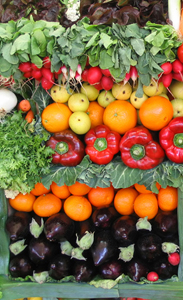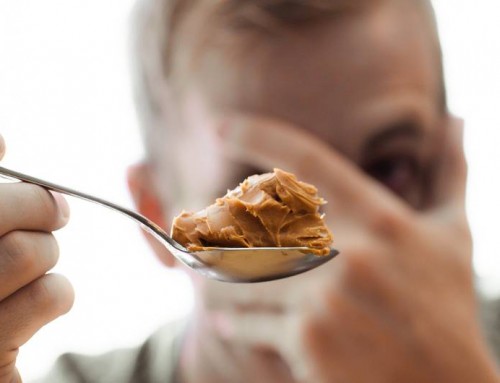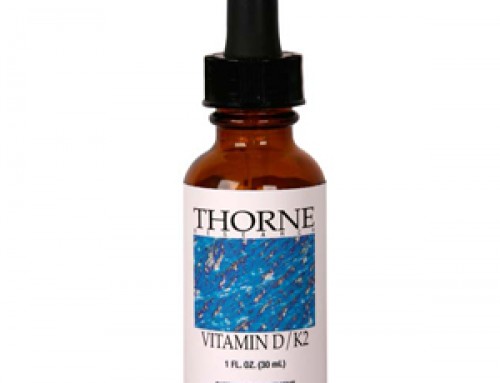 Now that we’re knocking on spring’s door with our CSA deliveries right around the corner, I wanted to take a few moments to share some awesome nutritional tidbits I picked up from Jo Robinson’s terrific book, Eating on the Wild Side. It’s packed full of almost 400 pages of meticulously researched information regarding purchasing, storing and preparing your fresh produce. I thought all of you might appreciate the Cliff Notes version of the book in order to bone up for fruit and veggie season. (The author’s quoted descriptions are in italics)
Now that we’re knocking on spring’s door with our CSA deliveries right around the corner, I wanted to take a few moments to share some awesome nutritional tidbits I picked up from Jo Robinson’s terrific book, Eating on the Wild Side. It’s packed full of almost 400 pages of meticulously researched information regarding purchasing, storing and preparing your fresh produce. I thought all of you might appreciate the Cliff Notes version of the book in order to bone up for fruit and veggie season. (The author’s quoted descriptions are in italics)
Lettuce and Salad Greens
The most nutritionally dense forms are the darker colors such as red, purple, dark green and reddish brown. You’ll want to choose the varieties with loose arrangements. The pale colored varieties that form a tight head are the least nutritious. Always purchase whole heads of lettuce as opposed to the bagged greens as it’s much more fresh and nutrient dense. Tearing your lettuce into bite sized pieces increases its anti-oxidant value. The most ideal way to store to preserve freshness is in a resealable plastic bag with approximately 10 to 20 pin prick holes. Squeeze out the air and store in the crisper.
Garlic
Garlic is rich in nutrients and is known to have remarkable health benefits. You’ll want shop for the plump, firm cloves enclosed in a tight outer wrapper. In order to benefit from its powerful nutrient, allicin, slice, mince, or press the garlic and then let it rest for ten minutes before exposing it to heat.
Onions
“Strongly flavored onions are best for your health. The more pungent the onion, the better it is for you. Bold-tasting red and yellow onions offer the most health benefits. Cooking tames their fire, brings out their sweetness , and increases their nutritional content. Small onions have more nutrients per pound than larger onions. Sweet, mild, and extra-large onions are less nutritious than bolder varieties. Boiling onions transfers many of their nutrients to the cooking liquid.”
Corn
The most colorful varieties are the best such as the black, blue, red or purple and will give you more bang for your buck in regards to phytonutrients than the more pale yellow and white strains. Do not boil corn as boiling leeches valuable nutrients into the water. Cooking corn in its husk is the most effective way to preserve the nutrient value. Canned and frozen organic corn can be as nutritious as fresh corn; however, it carries a higher glycemic index. The best way to eat corn is straight from your own garden!
Potatoes
The most colorful potatoes, such as the red, blue and purple are the most nutrient dense and provide more antioxidants than the white and yellow versions. The skin contains at least 50% of the antioxidants and slows down the digestion of the starch and the sugar, giving the potato a lower glycemic value. BUY ORGANIC! Conventional potatoes are heavily sprayed with pesticides. Rinsing and scrubbing WILL NOT remove these toxic compounds. You can greatly reduce the glycemic load by chilling potatoes twenty-four hours after they’ve been cooked.
Carrots
For the freshest and sweetest carrots, buy them with their green tops attached. Frozen carrots are much less nutrient dense than other frozen vegetables. Cooked carrots are more nutrient dense than raw carrots and contain three times more beta-carotene. Boiling carrots leeches much of the nutrients back into the cooking water. It’s best to steam or sauté them. There is no such thing as so called baby carrots. These have been trimmed and cut down to give their tiny appearance and many of the nutrients have been cut away. Whenever possible, choose purple carrots as they are more nutrient dense than the orange version.
Tomatoes
Small, dark red tomatoes have the most lycopene per ounce and are much sweeter and flavorful. BUY ORGANIC. Tomatoes are one of the most heavily sprayed crops and these compounds do not rinse off as they are absorbed into the plant. Like carrots, they’re better for you cooked than raw. In fact, the longer they’re cooked, the greater the health benefits. “Tomato paste, the most concentrated form of processed tomato, has up to ten times more lycopene than raw tomatoes.” Always store tomatoes at room temperature to preserve their flavor.
Broccoli
“Choose the freshest broccoli in the supermarket. Whole heads of broccoli have more nutrients than precut florets. Chill the vegetable as soon as you bring it home and eat it raw or cook it as soon as possible. If you keep the broccoli for more than a day, place it in a sealable plastic bag that you have pricked with about twenty tiny holes, and then place it in the crisper drawer of the refrigerator.”
Kale
Kale is king among all of the other cruciferous vegetables. Lab tests in animals have shown that Kale contains powerful cancer prevention agents and actually slows the growth of cancer cells. Unlike carrots, it is most nutritious when eaten raw. If you prefer to cook your kale, steam it briefly then serve with olive oil or quality butter. The best way to store is in a perforated, sealed plastic bag in the crisper. You can find kale year round at the local farmers’ markets.
Avocados
One serving of Avocado contains more antioxidants than a serving of broccoli, grapes, red bell peppers or red cabbage. Avocados are also an excellent source of fiber. The fat found in avocados is the healthy monounsaturated fat, the same fat found in avocado oil. The Hass avocado, found in most supermarkets has two to four times more antioxidants than the cheaper Florida avocados. The fat found in avocados helps aid in the absorption of fat soluble nutrients and they are high in potassium.
Apples
Apples with dark red skin contain more phytonutrients than the lighter colored version. Granny Smith apples are also very high in phytonutrients and tend to deliver a lighter glycemic load than the darker red versions. BUY ORGANIC! Conventional apples are heavily sprayed and as we discussed earlier, these compounds don’t just wash off. Apples should be stored in a cool, humid environment. Apples are most nutritious when freshly harvested, although, they can be stored anywhere from two weeks to a month, depending on what time of year they were harvested.
Berries (My favorite fruit!)
Blueberries and blackberries deliver the most nutritional bang for your buck. They’re high in vitamin C, anthocyanins, fiber and they carry a low glycemic load. Best of all, frozen berries are available year around and are almost as nutritious as seasonal fresh berries. When thawing frozen berries, thaw them quickly as slow thawing destroys many of the nutrients. I prefer to throw them in the frying pan with butter for an awesome breakfast or desert as cooking them actually enhances their phytonutrient value.
Strawberries
Strawberries are typically harvested when they are only three-quarters ripe and they cease to ripen any further as soon as they are picked. Your best bet is always your local market during the summer. You can increase antioxidant value by storing them at room temperature on the counter for a couple of days. As with the other berries, thaw frozen berries quickly to avoid nutrient loss. If you’re going to freeze them, dusting them with vitamin C powder or pectin will more effectively preserve their nutrient content.
So there’s your spring primer folks! Print this out and stick on the fridge for reference as you begin to gather up your spring and summer CSA’s. Feel free to hit me up if you have anything questions, concerns or something else to contribute and I’ll see you guys at the market!!
Michael










